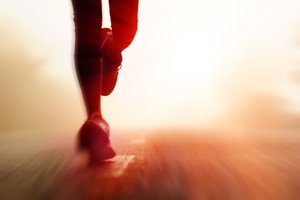Table of Contents
A Physical Therapist taking the online Building Better Bones course asked several questions regarding introducing an exercise program to clients with a history of osteoporosis and stress fractures.
The student also asked about the TRX Suspension System.

How to Introduce Exercise Activity After Stress Fracture
Question: I would like to know more about introducing impact activities (such as brisk walking, jogging, skipping and hoping) in premenopausal fairly active patients with a history of osteoporosis and stress fractures either in relation to the female athlete triad, from over training or underlying low bone density.
Response: In regards to prescribing activity to a patient following a history of osteoporosis and stress fractures, you need to look at the following:
- What caused the stress fracture, impact or muscular pull?
- What is the overall bone health status of the individual? You should inquire about their age, their general health, and their medication and supplement usage, and finally their diet?
- If the client is female, what is her percentage of body fat and menstrual cycle history?
- Are you introducing the impact activities to allow the individual to return to a sport or to build bone? If both are goals of the client, which of the two is the higher priority?
Does Location of Stress Fracture Matter?
Question: I understand that a history of osteoporosis and stress fractures is associated with an increased risk of incurring further stress fractures. Does the site of stress fracture (for example, hip, tibia, fibula) have any bearing on risk of further stress fractures?
Response: Not that I am aware of. There are case reviews of an individual sustaining numerous tibial stress fractures.
Osteoporosis and Stress Fractures
Question: Can the interaction of osteoporosis with this risk be factored into a training program?
Response: If an individual is wanting to get back onto a training program and you are concerned about recurrent stress fractures from impact, I suggest cross training with activities that do not require weight bearing such as biking, water running, and swimming.
TRX Suspension System
Question: What is your opinion of the value “TRX suspension”, where webbing straps of various heights hang from a beam overhead. This seems to be a ‘new’ thing in gyms. It seems to provide resistance work via own body weight with some balance, core control elements.
Response: I am familiar with the TRX suspension. There are no studies that I know of that studied the effect the usage of the product has had on bone health.
However, here are some points to consider:
- In an osteoporotic population my biggest concern would be torques around the spine, wrist, and hip. This should be a concern if the client is not appropriately progressed. I would begin with less unstable surfaces such as balls, discs, foam rollers, the Fitter, and Body Blade etc.
- I would want to ensure there is proper stabilization throughout the body.
- I would be very cautious to prescribe its use without supervision.
- I would not hesitate to use it with clients I am familiar with who are at an “elite” level in the MelioGuide program.
If you have taken the first four points into consideration, the TRX Suspension System is a lot fun and certainly a great tool for building core control in the “core” the hips and shoulders.
Physical Therapy Continuing Education
To learn more about how to Physical Therapy Continuing Education, visit my page dedicated to Physical Therapy Continuing Education.

Comments